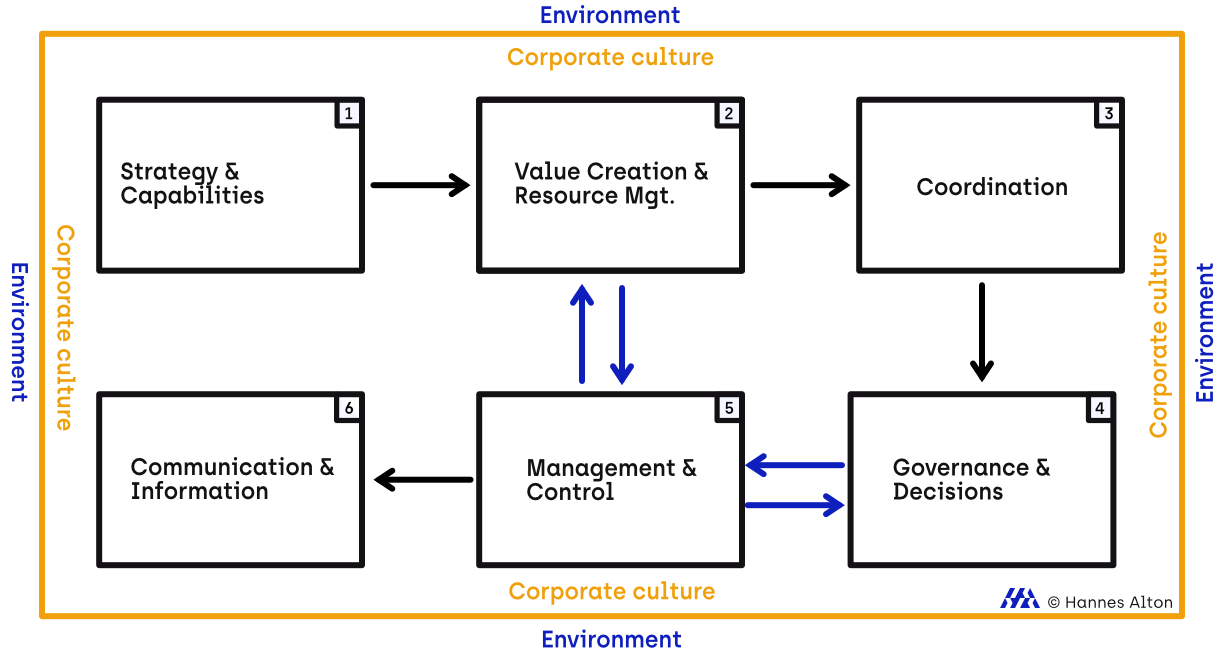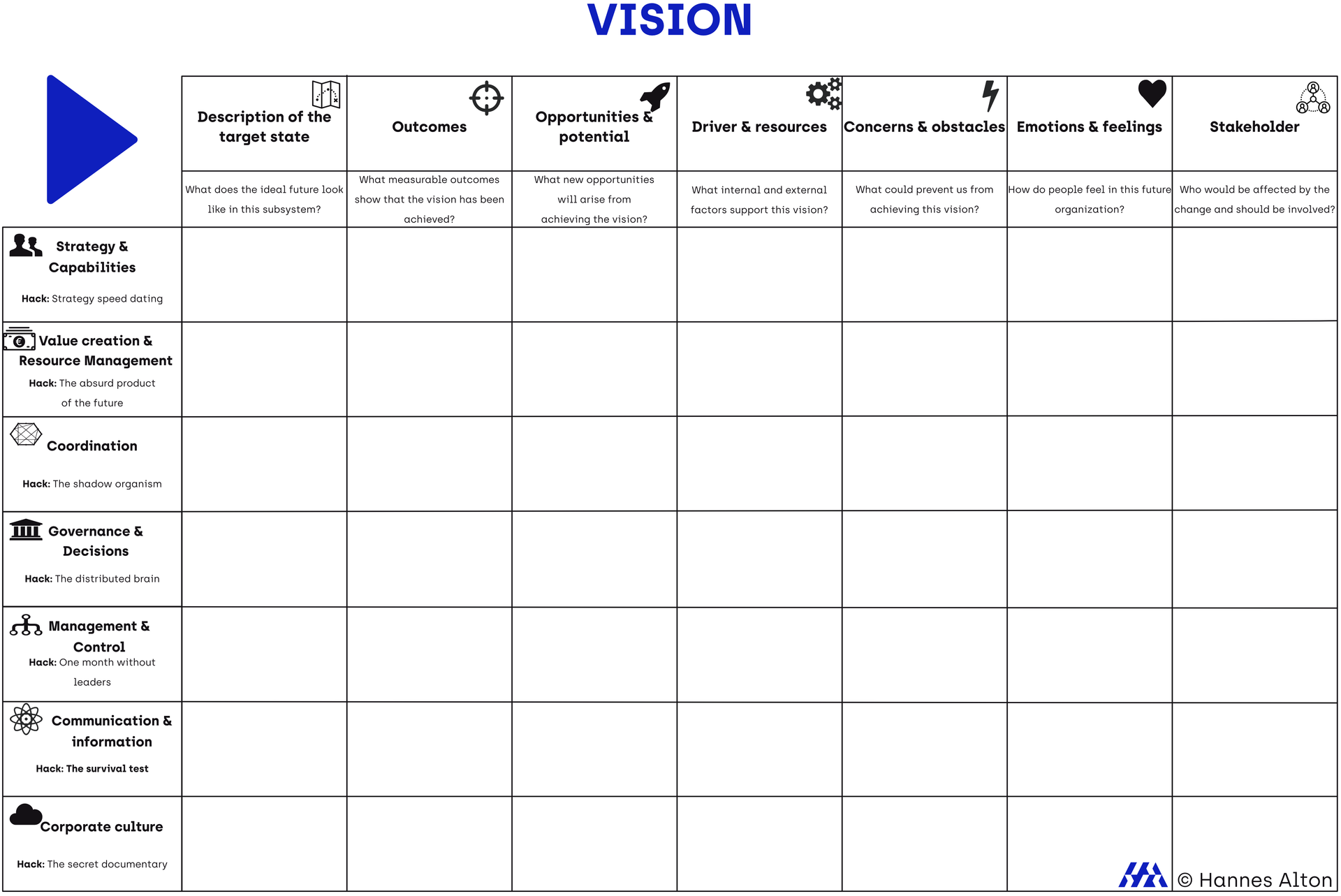Vector³: Building bridges between vision and reality
Every transformation needs a solid foundation. Puzzle Transformation provides the operating system. Vector3 delivers the basis for the co-creative development of the action architecture.
The launch of change projects is a critical phase that challenges companies to find answers to the following questions:
- WHAT do we want to achieve?
- WHAT needs to change?
- WHY is change necessary?
- WHERE should we start?
- WHO will be affected?
- WHAT risks are involved?
In the discussions, various opinions and perspectives are expressed. What is often lacking is a common understanding and commitment to the change process. Both are fundamental to successful change processes.
One approach to promoting both is co-creation.
The start
of change processes
Organizations are complex systems characterized by ambiguity.
Individuals perceive the same organization in various ways, each perspective being valid and neither right nor wrong. This can lead to feelings of uncertainty, a challenge that humans often struggle to cope with.
Complex systems such as organizations are inherently contradictory.
If people are not aware of this, it leads to discussions in which individuals talk at cross-purposes and, in my experience, one thing is missing at the end: a common understanding.
An analysis of the initial situation should provide clarity. However, classic analyses are not able to fully reflect the initial situation of a company. The current organization is a system that has been shaped by complex decisions made in the past and by the people who have worked in and continue to work within it.
A common understanding forms the foundation of successful change processes, which begins with a common language and a shared perception of the current organization.
I was confronted with this challenge several times, which led me to develop Vector3.
Vector³
Puzzle Transformation provides the operating system for change and Vector3 provides the format to make organization and change tangible and experiential.
Change is only possible through a shared understanding of the organization.
Vector3 is a workshop format based on co-creation. The goal is to develop a shared understanding of the organization and the change process.
Creating a shared understanding requires a foundational framework applicable to all organizations. In the Viable System Model (VSM), I identified the structural framework upon which the seven subsystems of an organization are built.
The seven subsystems of organizations
- Strategy & capabilities:
What long-term goals do we want to achieve?
Do we have the necessary resources and capabilities to support this initiative?
- Value creation & resource management:
How do we create value for our customers?
What resources are needed?
- Coordination:
How are activities coordinated with each other?
- Governance & decisions:
What rules & principles determine our actions?
How and at what level are decisions made (autonomy vs. hierarchy)?
- Management & control:
What management and control mechanisms are needed?
- Communication & information:
Is the required information flowing to the right places at the right time?
- Corporate culture:
What values and mental models shape our actions?

Working based on the seven subsystems ensures that all participants develop a common understanding of the organization.
The three modules of Vector3
Vector3 is based on the seven subsystems of organizations and consists of three modules:
- VectorMap
- VectorDelta
- VectorBlueprint
VectorMap is the module where the shared vision (goal) and the initial situation (reality) are defined.
In VectorDelta, vision and reality are considered together, creating an area of tension.
In VectorBlueprint, measures are established to bridge the gap between vision and reality.

Module 1: VectorMap
Clarity regarding the vision (goal) and the initial situation (reality) forms the basis for every successful change process.
Developing a vision: Looking ahead and into the future, the participants develop a target image for each subsystem.
Determining the starting point: The organization's current position is assessed based on its identical subsystems. In contrast to the vision, the focus is on the present.
Working in teams, participants use VectorMap to develop a shared perspective that incorporates the views of all those involved. This results in a shared understanding of the direction in which the organization wants to develop and its current standing.
Change inevitably involves risks, concerns, and emotions. VectorMap acknowledges these factors and incorporates them into the ongoing process.
Module 2: VectorDelta
Where changes should take place presents companies with the next challenge.
Building on the results of VectorMap, the seven subsystems are compared with each other. The joint consideration of vision and reality gives rise to an area of tension (delta). VectorDelta identifies which subsystems require action and which stakeholders are affected.
The results of VectorMap form the basis for the third module of Vector3, VectorBlueprint.
Module 3: VectorBlueprint
Many organizations struggle with determining the necessary measures to achieve their vision.
Based on the results of VectorDelta, participants in VectorBlueprint identify initial measures to overcome the tension between vision and reality. Following the logic of Puzzle Transformation, the measures are not worked out in detail at this stage, but represent an initial rough plan (blueprint).
This approach fosters a shared understanding and commitment, enabling realistic planning of the resources required.
Vector3 vs. conventional
analyses
Successful change and transformation projects require clarity and orientation. Both in terms of the vision (target image) and the path to achieving it.
Conventional analyses provide essential insights, but they are time-consuming and tie up resources. What is often lacking in most cases is a shared understanding.
Vector3 draws on elements of experience design to make the process tangible and experiential for all involved. Furthermore, a shared understanding of the organization and the change process is established from the beginning.
Features of Vector3:
- Scalability:
The format is applicable at all levels of the organization. From the corporate level to the divisional and departmental levels to the team level.
- Shared understanding:
Working in teams brings different (diverse) perspectives into the process, which helps develop a shared understanding.
- Empathy:
Change processes that do not consider the human perspective into account are ineffective. For this reason, concerns, worries, fears, and possible risks are taken into account in the workshop and incorporated into further considerations.
- Appropriate level of detail:
Vector3 is designed to help participants maintain focus and avoid getting lost in the details.
- Benefits:
y the end of the workshop, the company will have a solid foundation on which to develop measures further and determine the associated resource requirements.
.
Vector3 is a format that connects both on a technical and content level, as well as on a human and individual level.
Conclusion and outlook
Many change and transformation projects fail when it comes to answering fundamental questions. What is often missing is a shared understanding of the organization itself and where change could occur.
Vector3 is a tried-and-tested workshop format that closes this gap. The clear structuring of the process creates a solid basis on which change can take place, from the inside out and without “best practices.”
Curious about the next post? It's about how VectorDelta and VectorBlueprint are used to derive measures.
Would you like to start a change or transformation process?
Then let's talk. In a casual conversation, we will determine if Vector3 is suitable for your project and discuss how to lay the foundation for a successful start.



